The global floor screed market is projected to reach USD 27.3 billion by 2035, recording an absolute increase of USD 12.2 billion over the forecast period. The market is valued at USD 15.1 billion in 2025 and is set to rise at a CAGR of 6.1% during the assessment period. The overall market size is expected to grow by 1.8 times during the same period, supported by increasing urbanization and residential construction worldwide, driving demand for advanced flooring underlayment systems and increasing investments in commercial developments, infrastructure modernization, and energy-efficient building renovations globally.
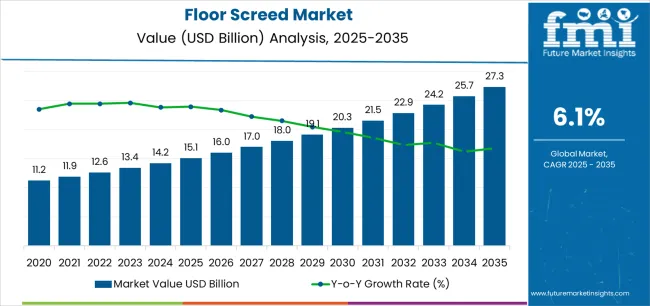
Between 2025 and 2030, the floor screed market is projected to expand from USD 15.1 billion to USD 20.3 billion, resulting in a value increase of USD 5.2 billion, which represents 42.6% of the total forecast growth for the decade. This phase of development will be shaped by rising demand for residential housing and commercial construction solutions, product innovation in fast-dry and self-leveling screed formulations, as well as expanding integration with underfloor heating systems and energy-efficient building initiatives. Companies are establishing competitive positions through investment in low-carbon formulation technologies, pump-applied delivery systems, and strategic market expansion across residential, commercial, and industrial construction applications.
From 2030 to 2035, the market is forecast to grow from USD 20.3 billion to USD 27.3 billion, adding another USD 7.0 billion, which constitutes 57.4% of the overall ten-year expansion. This period is expected to be characterized by the expansion of specialized sustainable screed systems, including advanced calcium sulfate and synthetic resin formulations tailored for specific performance requirements, strategic collaborations between material manufacturers and construction companies, and an enhanced focus on rapid installation and environmental sustainability. The growing emphasis on green building standards and fast-track construction methodologies will drive demand for advanced, high-performance floor screed solutions across diverse construction applications.
| Metric | Value |
|---|---|
| Market Value (2025) | USD 15.1 billion |
| Market Forecast Value (2035) | USD 27.3 billion |
| Forecast CAGR (2025-2035) | 6.1% |
The floor screed market grows by enabling construction contractors, architects, and property developers to achieve superior floor leveling and thermal performance while meeting evolving building quality and energy efficiency demands. Construction professionals face mounting pressure to accelerate project timelines and improve building performance, with modern floor screed systems providing 40-50% faster installation compared to traditional sand-cement screeds, making advanced formulations essential for residential developments, commercial buildings, and industrial facility construction. The green building movement's need for energy-efficient construction creates demand for advanced screed solutions that can enhance thermal performance through underfloor heating compatibility, enable rapid project completion, and ensure consistent floor quality across diverse construction conditions.
Government initiatives promoting energy-efficient housing and sustainable construction practices drive adoption in residential refurbishment, new commercial developments, and industrial applications, where floor quality has a direct impact on building performance and occupant comfort. The global shift toward rapid construction methodologies and prefabrication accelerates floor screed demand as builders seek materials that enable fast-track flooring installation and early trades access. The higher material costs for advanced formulations compared to traditional screeds and technical application requirements may limit adoption rates among price-sensitive small contractors and regions with limited access to specialized pumping equipment and technical expertise.
The market is segmented by screed type, end-use, material type, delivery method, and region. By screed type, the market is divided into bonded, floating, flowing, unbonded, and heated configurations. Based on end-use, the market is categorized into residential, commercial, and industrial applications. By material type, the market includes cementitious, calcium sulfate, and synthetic resin formulations. Based on delivery method, the market is segmented into ready-mix trucks, pump trucks, trans-mix trucks, and others. Regionally, the market is divided into North America, Europe, Asia Pacific, Latin America, and Middle East & Africa.
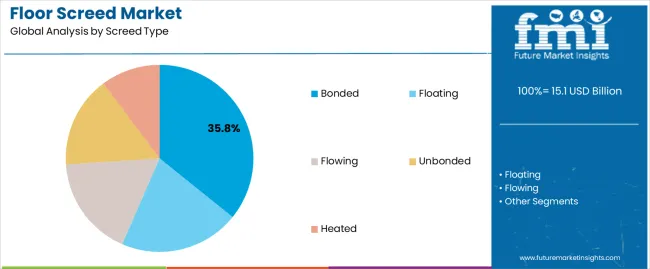
The bonded segment represents the dominant force in the floor screed market, capturing approximately 35.8% of total market share in 2025. This advanced category encompasses screed systems applied directly to concrete substrates with mechanical bonding, featuring superior load-bearing capacity, minimal thickness requirements, and enhanced durability, delivering comprehensive performance capabilities with optimal structural integration. The bonded segment's market leadership stems from its exceptional suitability for high-traffic commercial applications, superior performance in thin-section installations where height restrictions limit screed depth, and compatibility with renovation projects that require minimal floor buildup over existing structural slabs.
The floating segment maintains a substantial 23.4% market share, serving applications where acoustic or thermal insulation is required between the screed and structural substrate, particularly in residential multi-story construction. Flowing screeds account for 18.6% market share, offering self-leveling properties and rapid large-area coverage through pump application. Unbonded screeds represent 12.7% of the market, providing separation from the substrate through membrane layers for specific performance requirements. Heated screeds hold 9.5% market share, featuring integrated underfloor heating systems that enhance building thermal efficiency.
Key advantages driving the bonded segment include:
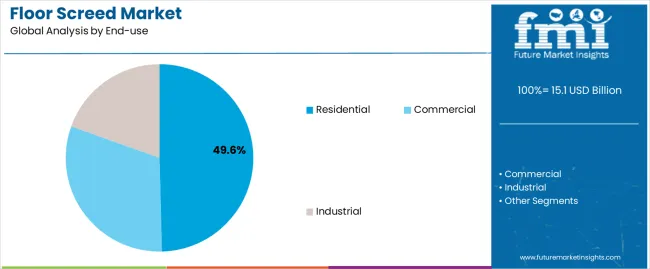
The residential segment represents the leading end-use category in the floor screed market, capturing approximately 49.6% of total market share in 2025. This critical segment encompasses single-family homes, multi-family housing developments, apartment buildings, and residential renovation projects where floor screed provides essential leveling, thermal mass, and surface preparation for final flooring installations. The residential segment's dominance reflects the fundamental role of floor screeds in modern housing construction, from ground-floor applications to upper-level installations supporting diverse flooring finishes.
The commercial segment maintains a substantial 34.1% market share, serving office buildings, retail developments, hospitality projects, and institutional facilities requiring durable floor systems with superior finish quality and rapid installation timelines. Commercial applications emphasize fast-dry formulations and flowing screeds that enable large-area coverage and quick turnaround for finishing trades. The industrial segment accounts for 16.3% market share, featuring heavy-duty screed installations in manufacturing facilities, warehouses, and logistics centers requiring exceptional load-bearing capacity and abrasion resistance.
Key factors driving residential segment leadership include:
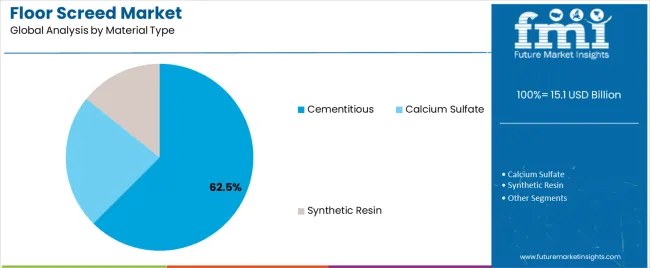
The cementitious segment represents the leading material category in the floor screed market, capturing approximately 62.5% of total market share in 2025. This critical material type encompasses traditional Portland cement-based screeds and modified formulations incorporating polymers and additives, where proven performance, cost-effectiveness, and wide availability support broad market adoption across residential and commercial construction. The cementitious segment's dominance reflects the fundamental advantages of cement-based systems including material familiarity among contractors, competitive pricing, and versatile application methods from hand-laid to pump-applied installations.
The calcium sulfate segment maintains a substantial 24.7% market share, serving applications where rapid drying, smooth surface finish, and underfloor heating compatibility are priorities, particularly in commercial and high-end residential projects. Calcium sulfate screeds offer advantages in flowing applications, providing self-leveling properties and accelerated drying times that reduce project schedules. The synthetic resin segment accounts for 12.8% market share, featuring specialized high-performance formulations for demanding industrial applications requiring chemical resistance, rapid cure times, or specific mechanical properties.
Key factors driving cementitious segment leadership include:
The market is driven by three concrete demand factors tied to urbanization and construction efficiency outcomes. First, rapid urban housing development and smart city initiatives create increasing requirements for efficient floor leveling systems, with residential construction activity growing 7-9% annually in emerging markets requiring modern screed solutions for multi-story apartment buildings, affordable housing projects, and urban infill developments supporting population growth. Second, energy-efficiency mandates and green building codes drive adoption of advanced screed systems, with underfloor heating installations requiring specialized screeds that provide 30-40% heating energy savings compared to conventional radiator systems while enabling rapid heat response and uniform temperature distribution across living spaces. Third, fast-track construction methodologies and prefabrication trends accelerate demand for rapid-dry screeds, with flowing and self-leveling formulations enabling 50-70% time savings compared to traditional screeds through pump application, reduced curing times, and early trades access supporting compressed project schedules.
Market restraints include raw material price volatility affecting project economics, with cement and specialty additives experiencing 15-25% price fluctuations impacting screed material costs and creating budgeting challenges for construction contractors operating on fixed-price contracts. Skilled labor shortages pose application quality challenges, as proper screed installation requires trained operatives understanding mixing ratios, application techniques, and curing procedures that ensure performance specifications, with labor availability constraints particularly acute in developed markets experiencing construction worker demographic transitions. Technical specification complexity and moisture management requirements create additional challenges, particularly with calcium sulfate screeds requiring controlled humidity conditions and extended drying periods before flooring installation, where improper moisture testing or accelerated schedules risk flooring failures and costly remediation work.
Key trends indicate accelerated adoption of low-carbon screed formulations in sustainable construction, particularly in European and North American markets where building regulations increasingly mandate embodied carbon reduction with manufacturers developing alternative binder systems, recycled content integration, and carbon capture technologies reducing screed environmental footprint by 30-50% compared to traditional formulations. Digital moisture monitoring and rapid-dry technology integration trends toward screeds equipped with embedded sensors, accelerated curing additives, and real-time moisture tracking systems are enabling predictive flooring readiness assessment and reduced construction program risks. The market thesis could face disruption if modular flooring systems or advanced substrate preparation technologies eliminate screed requirements in certain applications, or if 3D concrete printing achieves cost-effective floor surface creation, potentially reshaping construction methodologies and material selection priorities across residential and commercial building sectors.
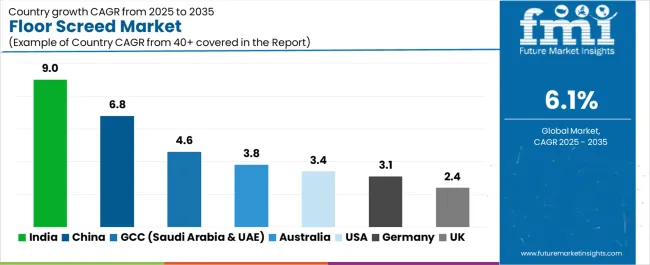
| Country | CAGR (2025-2035) |
|---|---|
| India | 9.0% |
| China | 6.8% |
| GCC (Saudi Arabia & UAE) | 4.6% |
| Australia | 3.8% |
| USA | 3.4% |
| Germany | 3.1% |
| UK | 2.4% |
The floor screed market is gaining momentum worldwide, with India taking the lead thanks to urban housing expansion and smart-cities programs driving rapid adoption of fast-dry and self-leveling screeds. Close behind, China benefits from large residential and commercial construction pipelines combined with green building codes boosting flowing and bonded screed applications, positioning itself as a strategic growth hub in the Asia-Pacific region. The GCC countries show strong advancement, where mega-projects and premium retail/hospitality fit-outs require rapid-dry solutions strengthening their role in Middle Eastern construction. Australia demonstrates robust growth through renovation waves and underfloor-heating uptake, signaling continued investment in residential improvement. Meanwhile, the USA stands out for retrofit demand and lightweight screeds in multifamily construction, while Germany and the UK continue to record consistent progress driven by energy-efficiency refurbishments and modular construction adoption. Together, India and China anchor the global expansion story, while established markets build stability and diversity into the market's growth path.
The report covers an in-depth analysis of 40+ countries, Top-performing countries are highlighted below.
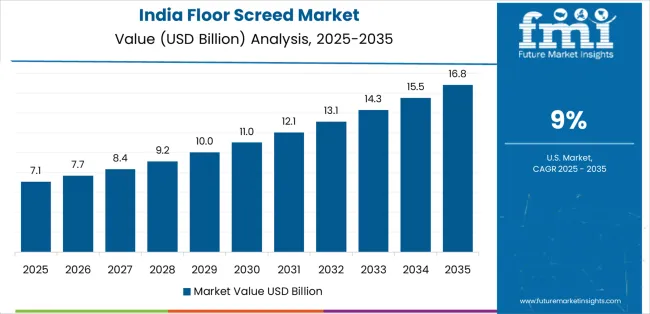
India demonstrates the strongest growth potential in the Floor Screed Market with a CAGR of 9.0% through 2035. The country's leadership position stems from comprehensive urban housing development programs, intensive smart city infrastructure initiatives, and rapid adoption of modern construction technologies driving implementation of fast-dry and self-leveling screed systems. Growth is concentrated in major metropolitan regions, including Mumbai, Delhi NCR, Bangalore, and Hyderabad, where high-rise residential projects, commercial developments, and affordable housing schemes are implementing advanced floor screed solutions for multi-story construction efficiency. Distribution channels through construction material suppliers, ready-mix concrete companies, and direct contractor relationships expand deployment across urban development clusters and housing project sites. The country's Housing for All mission and Smart Cities Mission provide policy support for construction modernization, including technology adoption programs and material quality standards implementation.
Key market factors:
In major urban centers, tier-two cities, and development corridors, the adoption of floor screed systems is accelerating across residential tower projects, commercial complexes, and industrial facility construction, driven by large-scale construction pipelines and green building standard implementation. The market demonstrates strong growth momentum with a CAGR of 6.8% through 2035, linked to comprehensive urbanization programs and increasing focus on building quality enhancement solutions. Chinese contractors are implementing flowing and bonded screed technologies to improve construction efficiency while meeting environmental standards in key urban regions including Beijing, Shanghai, Guangzhou, and Chengdu. The country's green building evaluation standards and construction industrialization initiatives create sustained demand for advanced screed solutions, while increasing emphasis on building energy efficiency drives adoption of underfloor heating compatible systems that enhance residential comfort.
The GCC region's expanding construction sector demonstrates sophisticated implementation of floor screed systems, with documented case studies showing 40-50% installation time reduction in commercial projects through pump-applied flowing screed adoption. The region's construction infrastructure in major development centers, including Riyadh, Dubai, Abu Dhabi, and Doha, showcases integration of premium screed technologies with high-specification building practices, leveraging expertise in large-scale mixed-use developments and hospitality construction. GCC contractors emphasize rapid installation and premium finish quality, creating demand for advanced screed formulations that support accelerated project schedules and luxury specification requirements. The market maintains strong growth through focus on mega-project delivery and commercial real estate development, with a CAGR of 4.6% through 2035.
Key development areas:
The Australian market demonstrates significant advancement in floor screed implementation based on residential renovation activity and underfloor heating system adoption for enhanced comfort. The country shows solid potential with a CAGR of 3.8% through 2035, driven by housing upgrade cycles and increasing emphasis on energy-efficient heating across major urban regions, including Sydney, Melbourne, Brisbane, and Perth. Australian contractors are adopting advanced screed formulations for renovation projects and new residential construction, particularly in cooler climate regions where underfloor heating provides efficient space heating solutions. Technology deployment channels through specialist flooring contractors, ready-mix suppliers, and builder merchant networks expand coverage across residential construction markets.
Leading market segments:
The U.S. market demonstrates mature implementation focused on multifamily residential construction and commercial retrofit applications, with documented integration achieving efficient floor preparation in high-rise and mixed-use developments. The country shows solid potential with a CAGR of 3.4% through 2035, driven by urban multifamily construction activity and retrofit demand across major metropolitan regions, including New York, Los Angeles, Chicago, and Sun Belt growth markets. American contractors are adopting lightweight screed formulations and low-VOC specifications for compliance with building codes and green building standards, particularly in multifamily projects requiring fire-rated floor assemblies and acoustic performance. Technology deployment channels through specialty contractors, material distributors, and design-build firms expand coverage across commercial and residential applications.
Leading market segments:
Germany's floor screed market demonstrates sophisticated implementation focused on energy-efficiency refurbishments and high-performance building systems, with documented integration of calcium sulfate screeds achieving optimal underfloor heating performance in residential retrofits. The country maintains steady growth momentum with a CAGR of 3.1% through 2035, driven by stringent energy regulations and contractors' emphasis on building performance principles aligned with passive house standards. Major construction regions, including Bavaria, North Rhine-Westphalia, Baden-Württemberg, and Berlin-Brandenburg, showcase advanced deployment of flowing screed systems that integrate seamlessly with existing building renovation programs and energy-efficiency upgrade initiatives.
Key market characteristics:
The United Kingdom's floor screed market demonstrates mature implementation focused on repair/maintenance cycles and modular construction methodologies, with documented integration achieving efficient floor preparation in residential refurbishment and new-build housing programs. The country maintains steady growth through housing renovation activity and construction innovation, with a CAGR of 2.4% through 2035, driven by building stock maintenance requirements and policy support for housing delivery acceleration. Major construction regions, including Southeast England, Midlands, Northwest England, and Scotland, showcase advanced screed deployment where contractors integrate pump-applied flowing screeds with modern construction methods for enhanced productivity.
Key market characteristics:
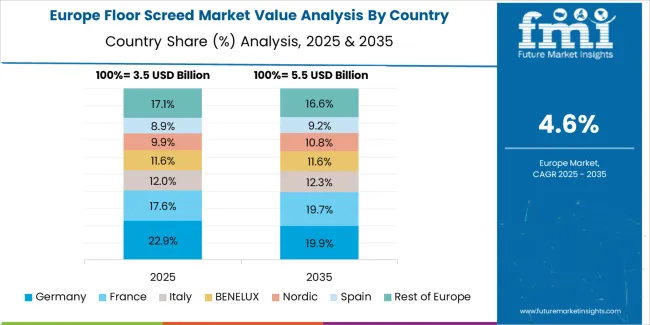
The floor screed market in Europe accounts for 36.5% of global demand, representing approximately USD 5.5 billion in 2025. Germany leads with approximately 18.0% of European market share, supported by its advanced building renovation infrastructure and stringent energy-efficiency standards across Bavaria, North Rhine-Westphalia, and Baden-Württemberg regions. The United Kingdom follows with a 14.0% share, driven by residential refurbishment programs and new housing delivery targets. France holds a 13.0% share, supported by commercial construction activity and residential renovation markets. Italy commands a 12.0% share, backed by building restoration projects and new construction developments. Spain accounts for 8.0% through residential construction recovery and tourism-related commercial projects. The Nordic countries represent 10.0% with strong sustainable construction practices and underfloor heating adoption, while Benelux maintains 6.0% share through renovation activity and new residential development. Central & Eastern Europe holds 19.0% share, driven by residential construction expansion, EU-funded infrastructure projects, and growing adoption of modern construction materials across Poland, Czech Republic, Romania, and other emerging markets. Residential refurbishments and energy-efficiency mandates favor cementitious bonded and pump-applied flowing screeds across the region, with Western Europe increasingly adopting low-carbon and rapid-dry formulations supporting sustainable construction objectives.
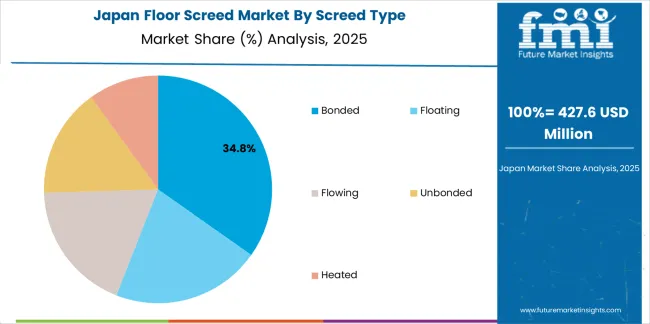
The Japanese floor screed market demonstrates a mature and quality-focused landscape, characterized by sophisticated integration of precision-leveling systems and high-performance formulations with existing construction practices across residential high-rise developments, commercial buildings, and renovation projects. Japan's emphasis on building quality and seismic performance drives demand for certified floor screed systems that support structural requirements and finish quality expectations in premium domestic construction standards. The market benefits from strong partnerships between international material manufacturers and domestic construction material distributors including contractor associations, creating comprehensive service ecosystems that prioritize installation quality and technical support programs. Construction centers in Tokyo, Osaka, Nagoya, and other major urban areas showcase advanced screed implementations where flooring programs achieve exceptional levelness through precision application techniques and quality control systems.
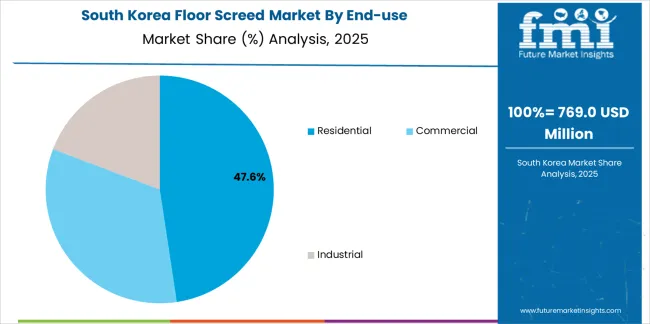
The South Korean floor screed market is characterized by growing international material provider presence, with companies maintaining significant positions through comprehensive technical support and application training capabilities for high-rise residential and commercial construction. The market demonstrates increasing emphasis on rapid-installation systems and high-performance formulations, as Korean contractors increasingly demand advanced screed materials that integrate with domestic construction practices and sophisticated building management systems deployed across modern developments. Regional material distributors are gaining market share through strategic partnerships with international manufacturers, offering specialized services including pump application support and performance testing programs for demanding construction applications. The competitive landscape shows increasing collaboration between multinational material companies and Korean construction technology specialists, creating hybrid service models that combine international product development expertise with local contractor knowledge and construction practice requirements.
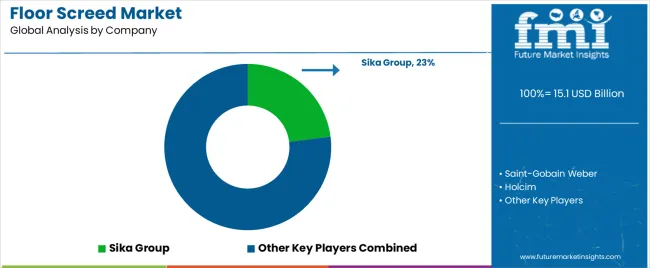
The floor screed market features approximately 12-18 meaningful players with moderate concentration, where the top three companies control roughly 25-30% of global market share through established distribution networks and comprehensive product portfolios. Competition centers on product performance reliability, technical support capabilities, and regional distribution strength rather than price competition alone. Sika Group leads with approximately 9.5% market share through its comprehensive flooring systems and screed product portfolio spanning residential, commercial, and industrial applications.
Market leaders include Sika Group, Saint-Gobain Weber, and Holcim, which maintain competitive advantages through global manufacturing infrastructure, extensive technical support networks, and deep expertise in construction materials across multiple building segments, creating trust and reliability advantages with contractors, architects, and property developers. These companies leverage research and development capabilities in sustainable formulations and ongoing technical service relationships to defend market positions while expanding into rapid-dry technologies and low-carbon product lines.
Challengers encompass Mapei S.p.A. and Ardex Group, which compete through specialized flooring systems and strong presence in professional contractor markets. Product specialists, including Knauf, CEMEX, and Fosroc International, focus on specific market segments or regional applications, offering differentiated capabilities in material formulations, technical training programs, and application support services. Regional players including Tarmac and Pidilite Industries (Dr. Fixit) create competitive pressure through localized manufacturing advantages and responsive distribution capabilities, particularly in high-growth markets where proximity to construction sites provides advantages in delivery logistics and technical support relationships.
Floor screed systems represent essential construction materials that enable contractors to achieve 40-50% faster installation compared to traditional sand-cement screeds, delivering superior floor leveling and thermal performance with proven durability in residential, commercial, and industrial building applications. With the market projected to grow from USD 15.1 billion in 2025 to USD 27.3 billion by 2035 at a 6.1% CAGR, these critical flooring underlayment systems offer compelling advantages - rapid installation, thermal efficiency, and superior finish quality - making them essential for residential construction (49.6% market share), commercial developments (34.1% share), and building projects requiring floor preparation that conventional methods cannot deliver efficiently.
How Governments Could Spur Local Production and Adoption?
How Industry Bodies Could Support Market Development?
How OEMs and Technology Players Could Strengthen the Ecosystem?
How Suppliers Could Navigate the Shift?
How Investors and Financial Enablers Could Unlock Value?
| Item | Value |
|---|---|
| Quantitative Units | USD 15.1 Billion |
| Screed Type | Bonded, Floating, Flowing, Unbonded, Heated |
| End-use | Residential, Commercial, Industrial |
| Material Type | Cementitious, Calcium Sulfate, Synthetic Resin |
| Delivery Method | Ready-mix Trucks, Pump Trucks, Trans-mix Trucks, Others |
| Regions Covered | North America, Europe, Asia Pacific, Latin America, Middle East & Africa |
| Country Covered | India, China, GCC (Saudi Arabia & UAE), Australia, USA, Germany, UK, and 40+ countries |
| Key Companies Profiled | Sika Group, Saint-Gobain Weber, Holcim, Mapei S.p.A., Ardex Group, Knauf, CEMEX, Fosroc International, Tarmac, Pidilite Industries (Dr. Fixit) |
| Additional Attributes | Dollar sales by screed type, end-use, material type, and delivery method categories, regional adoption trends across Asia Pacific, Europe, and North America, competitive landscape with material manufacturers and distribution networks, technical specifications and performance requirements, integration with underfloor heating systems and building management platforms, innovations in rapid-dry technology and sustainable formulations, and development of specialized floor screed systems with enhanced installation efficiency and environmental compliance capabilities. |
The global floor screed market is estimated to be valued at USD 15.1 billion in 2025.
The market size for the floor screed market is projected to reach USD 27.3 billion by 2035.
The floor screed market is expected to grow at a 6.1% CAGR between 2025 and 2035.
The key product types in floor screed market are bonded, floating, flowing, unbonded and heated.
In terms of end-use, residential segment to command 49.6% share in the floor screed market in 2025.






Full Research Suite comprises of:
Market outlook & trends analysis
Interviews & case studies
Strategic recommendations
Vendor profiles & capabilities analysis
5-year forecasts
8 regions and 60+ country-level data splits
Market segment data splits
12 months of continuous data updates
DELIVERED AS:
PDF EXCEL ONLINE
Floor Standing Filtered Bottle Filling Stations Market Size and Share Forecast Outlook 2025 to 2035
Floor Cleaner Market Size and Share Forecast Outlook 2025 to 2035
Floor Transition Strips Market Analysis - Size, Share, and Forecast Outlook 2025 to 2035
Floor Scales Market Size and Share Forecast Outlook 2025 to 2035
Floor Lamp Market Size and Share Forecast Outlook 2025 to 2035
Floor Cleaning and Mopping Machine Market Size and Share Forecast Outlook 2025 to 2035
Floor Marking Tape Market Analysis - Size and Share Forecast Outlook 2025 to 2035
Flooring Market Size and Share Forecast Outlook 2025 to 2035
Floor Displays Market Growth from 2025 to 2035
Flooring and Carpets Market - Trends, Growth & Forecast 2025 to 2035
Floor Grinding Machine Market
Bus Flooring Market Growth – Trends & Forecast 2025 to 2035
Eco Flooring Market Analysis - Growth, Demand & Forecast 2025 to 2035
Gas Floor Fryers Market
Underfloor Heating Market Size and Share Forecast Outlook 2025 to 2035
Underfloor Air Distribution Systems Market
Vinyl Flooring Market Growth - Trends & Forecast 2025 to 2035
Pelvic Floor Diagnostics Market - Demand & Forecast 2025 to 2035
Pelvic Floor Stimulators Market – Trends & Forecast 2025 to 2035
Pelvic Floor Diagnostic Testing Market

Thank you!
You will receive an email from our Business Development Manager. Please be sure to check your SPAM/JUNK folder too.
Chat With
MaRIA